Model Engine Gallery Page 11
Click on the images to view them larger size.
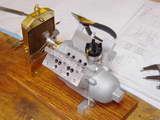
|
Here's a Bob Shores' designed PeeWee V4 being built by Bob Shutt from Dirk's casting kit. Look at that radiator! Really draws my attention away from the excellent work being done on the engine itself. Dirk is preparing a plan set for the radiator that will be made available in the fullness of time. |
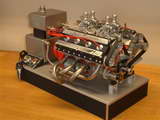
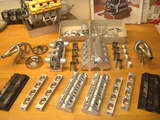
|
This DOHC 76cc V8 was built by Rolf Luther and was aquired by Mark Thomas for a simple King's Ransom. Now apart from the fabulous workmanship, look at the little things, like the way the exhaust headers are of equal length and curl around each other to join up—now figure out how you would approach that job, then consider that this is only a small aspect of the overall engine. |
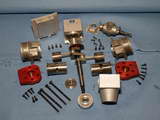
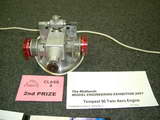
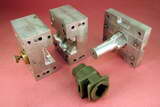
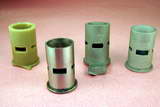
|
This is the sort of thing that ECJ Editor, Tim Dannels says gives him and other model engine historians giant, throbbing headaches—a home-built engine so professional that it looks like it must be a mass produced factory job!
It is the work of North Wales (UK) MEM Member, John Feeney. The engine is his own design Tempest 90 opposed twin, simultaneous firing, twin-cylinder, RRV, Schnurle ported two-stroke. On first glance, I thought John had used ASP or Leo cylinder castings, but not a bit of it! As you can see, the cylinders are lost wax investment castings made to John's design, using dies he also made (the actual casting work is farmed out to a local foundry). This is not a trivial undertaking, but John believes that it is worth it when multiple parts are involved. But wait, as they say, there's more! John also had his liners produced the same way! This is unusual, but not without precedent, being pioneered by ETA for their high performance team race diesel. As you can see from the second photo, John's engine earned a well deserved second place award at the 2007 Midlands Model Engineering Exhibition. The two-throw crankshaft is fabricated—you can see the pressed in crankpins if you look closely. This requires careful jigging during drilling and assembly, but simplifies the conrod big-end and results in the most compact assembly at the expense of maintenance. The cast liners, which appear to have been ground, allow accurate placement of the ports with greatly reduced manufacture time and hence cost (after the die is done). |
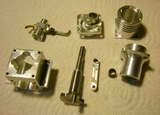
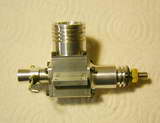
|
Here's an original design from a reader who confesses to having been inspired to cut metal by pictures and words on this site. Although not a new to engine work (John has reworked F1C engines), he has never made a complete engine. This one is "square"; bore and stroke being 0.625" for 0.19cuin displacement. The design reflects experience with Rossi and other performance engines being Schnurle ported. The cooling jacket fixing position allows the ports to be milled easily, like but not the same as the Taipan 2.5 BB RE which inspired the Cox Conquest. The crank is supported in twin ball races and induction is via a rear rotary valve. The lines/piston combo will be steel/CI as a trial, not a serious flying engine. All this work was done between Christmas and New Year, 2007, so we should see results real soon. |
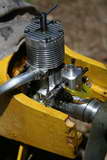
|
Enjoyable as building you own engine is as an end of itself, it's really great to see experimentation in model engine design and construction by amateurs that is aimed at achieving success in actual competition events! The engine seen here was designed abd built by Trev Boundy and Fred Stebbing. It is one of a pair of .40 cuin "diesel" engines they developed over time that are explicitly designed for the "Texaco" class where fuel economy can play such a vital role. The designers began development with OS .45 ringed glow engines, making new liners, pistons and heads to build a .40 diesel. They have now prohressed to a complete engine design with barstock crankcase. The piston and liner are cast iron, the former being chromed. The nose of the model seen here looks like a real work-horse, underpinning the amount of testing and development they have and are undertaking. Great effort, guys. |
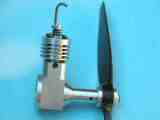
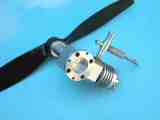
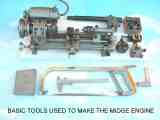
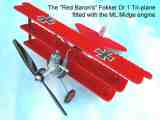
|
About a year ago, I had an email from Orville Olm of GizmoGeezer Products (you just gotta' love that name!) asking after our Imperial CAD redraw of the ML Midge plans, saying he was having trouble with the original metric plans that had appeared in the magazine and was determined, by hook or by crook, not to let the project beat him!
Well, as can be seen here, Orv has succeeded brilliantly, using the simplest of equipment: a little Unimat lathe and a hacksaw! This has been his his first engine project, which on and off—mostly off—has taken a mere ten years (you can't rush these things). Rather than just display it statically, Orv made a lovely little Walt Musciano designed Fokker Triplane (as kitted by the Scientific Model Airplane Co, way back when) and flew it all weekend tethered over the heads of the crowds at a Canadian Model Engineering show. Naturally, the kids loved it and Orv is now considering what his next engine project will be. |
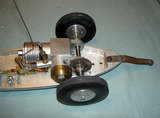
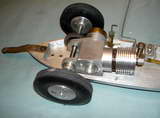
|
This a replica "Integral gear" Oliver Mk 2 motor I made by David Cunliffe (UK) several years ago. David believes that Oliver made only seven of the originals in the 1950's that which went to Sweden. The motor pictured here was taken to Hannover for the 50th Anniversary race in August 2007 and was run there. |
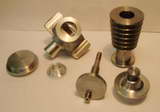
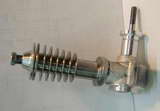
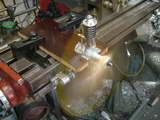

|
Aussie engine builder, Rob Jenkins, is on the home straight now with his Nova, and unlike me, he only had to make one cylinder! It's a big and rather ungainly lump of an engine, but it is astonishingly well behaved and easy to adjust, with reasonably good power. On second thought, there is the fuel tank to consider. Bert Streigler made the tanks for the Motor Boys' engines and still has nightmares about them, so maybe Rob is not as close to done as I thought at first.
Update 2007-11-17: Rob's Nova is running! To save a bit of time, he machined a clear tank from perspex rod (two of them actually, but we won't talk about that). The engine is still tight, but it starts second flick and turns a 13-1/2 prop with ease. It's also very "well behaved" for a large diesel. Remember, plans are in the MBI Book and castings are available from Roger Schroeder. Update 2007-11-27: Last update received from Rob—his Nova now has a beautifully made brass tank with spun end caps, just like the Motor Boys' Nova tanks. Doing brasswork like this is not difficult, but it does require a disproportionate amount of care and attention to detail. The reward is a thing of beauty, admired by all. Eagle-eyed readers may spot a small, nicely made, unobtrusive brass dimple behind the fuel feed tube. Rob does not want to talk about it. |
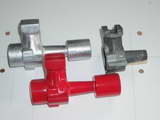
|
John Malkin, one of out Kiwi readers, was presented with a rather sad Mills 2.4 that had received a dunking to see what he could do with it. As the answer was "not a lot", he recalled the page on patternmaking and used the info to try his hand at the Art. The result, both pattern and sand casting, look good to me. Give the case a bit of sand blasting and it will look at least as good as the poor old magnesium original, and last far longer! |
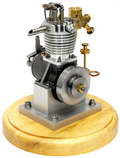
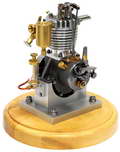
|
You could be excused in thinking that this is an example of ETW's Kiwi Mk II based on some rather precise investment castings. You'd be half right—it is a Kiwi made precisely to the ETW plans, but it is made 100% from bar-stock—in fact, the crankcase is sand-blasted mild-steel! The builder, Jim Winrow (UK), said in his email that he'd built it as a spot of relief from more demanding projects. I'd expect to see this engine gathering some attention and awards at future UK model engineering shows; simply outstanding work from the rockers, down to the engine mount, and everything in between. The only negative is the vague, nagging feeling of inadequacy it instils as regards the quality of my own work. This cannot be tolerated so I went looking for flaws. I think I found it: the left hand cylinder flange stud on the flywheel side is showing half a turn too much thread above the nut (all the rest are perfect, grrrr...) |
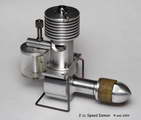
|
On first glance, it's a Speed Demon. On second glance, it's still a Speed Demon, but a shop-made one that's shrunk to 2.5cc displacement. So far it's a one of a kind, made by the Empire Motor Boy (EMB), Ken Croft. This engine appealed to us as it required no castings and has a most unusual compression adjustment, as you can read in the review of the full-size counter-part. |
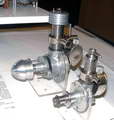

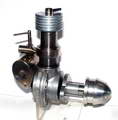
|
There is some confusion regarding which was the first compression ignition model engine (aka "diesel"). In his book, Collector's Guide to Model Engines, Peter Fisher give the credit to the engine seen here, known as the Etha. Laidlaw-Dickson's Model Diesels gives the credit to the Klemenz-Schnek designed Dyno. Both came from Switzerland in the early 1940's and the general opinion is that the blue ribbon should go to the Etha.
The finless one is the Etha D, 2.5cc in displacement, which Fisher dates as being commercially available in 1941. He mentions a larger one of more than 10cc displacement which could be the other model in the pictures. These photos were taken by Tim Dannels, editor of The Engine Collectors' Journal and AMEE at the recent MECA EXPO gathering. the engines are from the Darrel Peugh collection and while I'm not sure about the polish job, the engines are genuine enough. For a look at a nice shop built replica Etha, have a look at the Les Stone page. |
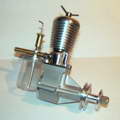
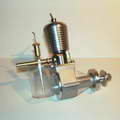
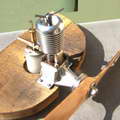
|
This Sparey 5cc diesel—aka, The Aeromodeller Diesel was built by Australian, Rob Jenkins. Rather than use a casting for the case, Ron hogged it from a solid block of ally. He was going to polish out all the milling marks when I suggested sand blasting instead. The results are just great (in my humble opinion). In fact, you'd be hard pressed in these photos to tell it is not a casting! Rob also side-stepped the problem of aligning fore-aft the cooling fins normally cut on top of the screw-on head; he left them out! Now say what you will about door-knobs, the polished contour has a certain charm... Rob reports it starts easily and runs well, even if initial tests did shake the soft-soldered venturi bits to pieces. |

|
I get a real kick out of seeing engines built from The Motor Boys Plan Book. This Nova 1 was built by Olle Eriksson of Stockholm, Sweden. Olle sand cast his own case from his own pattern. He reports that it runs just fine, spinning a 12-6 prop at 5,200 rpm. He adds that his cylinder is from free cutting steel and while a bit nerve cracking to make, he got through on the first attempt— which is a lot better than I managed! Make special note of the soldering job on the end caps of the fuel tank (spun from brass). Soldering this neat and regular is the mark of a true craftsman. |
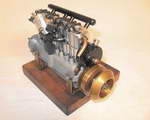
|
I truely wish I could find where this photograph came from. It shows a water cooled DH Cirrus Mk I obviously made from the 1/6th scale Zimmerman/Dubiel castings. The widget at the front is a water pump driven from a gear cut in the flywheel, and the carburetor has been fitted to feed the inlet first, then dribble down into the crancase for big end lubrication (the opposite to the Zimmerman design which feeds the inlet via the crankcase). |
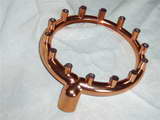
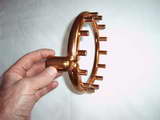

|
This is an exhaust collector ring for the 1/6 scale model of the Pratt & Whitney R-1830 dual-bank, 14 cylinder radial shown at the top of Page 10 of the Gallery. Before you fall prey to terminal feelings of inadaquecy in the face of the brazing job, take heart: this is no brazing job! The component was formed in one piece by electro-deposition over a plug formed from fixturing alloy (it's ok to feel inadequate over just how perfect that model must have been though).
While I've seen small parts electro-deposited in a copper sulphate solution using a car battery in the workshop, this one was done commercially with Bruce Satra overseeing the project. Bruce is also producing the lost wax castings for the rest of the engine. He says that while the ring is magnificant, so is the cost with "Cerobend" fixturing allow running at $25 per pound. While it can be recovered and reused, doing rings one at a time is not economically viable. You need to do four or more at once and that is a lot of Corobend! |
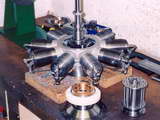
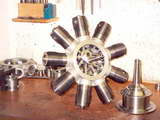
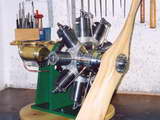
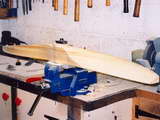
|
This very fine 40% scale Gnome nine cylinder Monosoupape rotary was built by Jim Winrow in the UK. The result is a very large engine, as can be appreciated by the photo showing the relative size of the 4" Record #3 bench vice holding the laminated propeller blank for carveing. The engine gained a well deserved Best in Class at the 2005 Harrowgate Exhibition.
Jim is currently finishing a 7-1/2 gauge live steam locomotive, but is already thinking about his next IC project which he intends to be the Clerget rotary. In anticipation, he is busily collecting research data for the project. Naturally he has the Camden book, but would welcome information regarding any other good references containing detailed information of the Clerget. |